Rainfall-Induced Landslide Susceptibility Using a Rainfall–Runoff Model and Logistic Regression
Abstract
:1. Introduction
2. Materials and Methods
2.1. Study Area
2.2. Basic Data Collection
2.3. Rainfall Distribution Estimation
2.4. Rainfall-Runoff Model
2.5. Logistic Regression Analysis
2.6. Landslide Inventories
2.7. Factors of Landslide Susceptibility Model
3. Results
3.1. Rainfall-Runoff Analysis
3.2. Landslide Susceptibility Analysis
4. Discussion
5. Conclusions
Author Contributions
Funding
Conflicts of Interest
References
- Guzzetti, F.; Carrara, A.; Cardinali, M.; Reichenbach, P. Landslide hazard evaluation: A review of current techniques and their application in a multi-scale study, Central Italy. Geomorphology 1999, 31, 181–216. [Google Scholar] [CrossRef]
- Caine, N. The rainfall intensity-duration control of shallow landslides and debris flows. Geogr. Ann. Ser. A Phys. Geogr. 1980, 62, 23–27. [Google Scholar]
- Atkinson, P.M.; Massari, R. Generalised linear modelling of susceptibility to landsliding in the central Apennines, Italy. Comput. Geosci. 1998, 24, 373–385. [Google Scholar] [CrossRef]
- Bai, S.B.; Wang, J.; Lu, G.N.; Zhou, P.G.; Hou, S.S.; Xu, S.N. GIS-based logistic regression for landslide susceptibility mapping of the Zhongxian segment in the Three Gorges area, China. Geomorphology 2010, 115, 23–31. [Google Scholar] [CrossRef]
- Dai, F.C.; Lee, C.F. Landslide characteristics and slope instability modeling using GIS, Lantau Island, Hong Kong. Geomorphology 2002, 42, 213–228. [Google Scholar] [CrossRef]
- Dai, F.C.; Lee, C.F. A spatiotemporal probabilistic modelling of storm-induced shallow landsliding using aerial photographs and logistic regression. Earth Surf. Process. Landf. 2003, 28, 527–545. [Google Scholar] [CrossRef] [Green Version]
- Dai, F.C.; Lee, C.F.; Li, J.; Xu, Z.W. Assessment of landslide susceptibility on the natural terrain of Lantau Island, Hong Kong. Environ. Geol. 2001, 40, 381–391. [Google Scholar]
- Guns, M.; Vanacker, V. Logistic regression applied to natural hazards: Rare event logistic regression with replications. Nat. Hazards Earth Syst. Sci. 2012, 12, 1937–1947. [Google Scholar] [CrossRef]
- Jade, S.; Sarkar, S. Statistical models for slope instability classification. Eng. Geol. 1993, 36, 91–98. [Google Scholar] [CrossRef]
- Lee, S.; Min, K. Statistical analysis of landslide susceptibility at Yongin, Korea. Environ. Geol. 2001, 40, 1095–1113. [Google Scholar] [CrossRef]
- Ohlmacher, G.C.; Davis, J.C. Using multiple logistic regression and GIS technology to predict landslide hazard in northeast Kansas, USA. Eng. Geol. 2003, 69, 331–343. [Google Scholar] [CrossRef]
- Van Den Eeckhaut, M.; Vanwalleghem, T.; Poesen, J.; Govers, G.; Verstraeten, G.; Vandekerckhove, L. Prediction of landslide susceptibility using rare events logistic regression: A case-study in the Flemish Ardennes (Belgium). Geomorphology 2006, 76, 392–410. [Google Scholar] [CrossRef]
- Koukis, G.; Ziourkas, C. Slope instability phenomena in Greece: A statistical analysis. Bull. Int. Assoc. Eng. Geol. 1991, 43, 47–60. [Google Scholar] [CrossRef]
- Chan, H.C.; Chang, C.C.; Chen, S.C.; Wei, Y.S.; Wang, Z.B.; Lee, T.S. Investigation and Analysis of the Characteristics of Shallow Landslides in Mountainous Areas of Taiwan. J. Chin. Soil Water Conserv. 2015, 46, 19–28. (In Chinese) [Google Scholar]
- Central Weather Bureau, Taiwan, 2017: Records of Historical Typhoons. Available online: http://www.cwb.gov.tw (accessed on 12 June 2018). (In Chinese)
- Pradel, D.; Raad, G. Effect of permeability on surficial stability of homogeneous slopes. J. Geotech. Eng. 1993, 119, 315–332. [Google Scholar] [CrossRef]
- Guzzetti, F.; Peruccacci, S.; Rossi, M.; Stark, C.P. The rainfall intensity–duration control of shallow landslides and debris flows: An update. Landslides 2008, 5, 3–17. [Google Scholar] [CrossRef]
- Shou, K.J.; Yang, C.M. Predictive Analysis of Landslide Susceptibility under Climate Change Conditions—A Study on the Chingshui River Watershed of Taiwan. Eng. Geol. 2015, 192, 46–62. [Google Scholar] [CrossRef]
- Tseng, C.M.; Chen, Y.R.; Wu, S.M. Scale and spatial distribution assessment of rainfall-induced landslides in a catchment with mountain roads. Nat. Hazards Earth Syst. Sci. 2018, 18, 687–708. [Google Scholar] [CrossRef]
- Chow, V.T.; Maidment, D.R.; Mays, L.W. Applied Hydrology; McGraw-Hill: New York, NY, USA, 1988. [Google Scholar]
- Chen, C.N.; Tfwala, S.S. Impacts of Climate Change and Land Subsidence on Inundation Risk. Water 2018, 10, 157. [Google Scholar] [CrossRef]
- Chen, C.N.; Tsai, C.H. The Impact of Climate Change on Inundation Potential. Int. J. Environ. Sci. Dev. 2013, 4, 496–500. [Google Scholar] [CrossRef]
- Chen, C.N.; Tsai, C.H.; Tsai, C.T. Simulation of sediment yield from watershed by physiographic soil erosion–deposition model. J. Hydrol. 2006, 327, 293–303. [Google Scholar] [CrossRef]
- Chen, C.N.; Tsai, C.H.; Tsai, C.T. Reduction of discharge hydrograph and flood stage resulted from upstream detention ponds. Hydrol. Process. 2007, 21, 3492–3506. [Google Scholar] [CrossRef]
- Chen, S.C.; Chang, C.C.; Chan, H.C.; Huang, L.M.; Lin, L.L. Modeling typhoon event-induced landslides using GIS-based logistic regression: A case study of Alishan Forestry Railway, Taiwan. Math. Prob. Eng. 2013. [Google Scholar] [CrossRef]
- Shiau, J.T.; Chen, C.N.; Tsai, C.T. Physiographic drainage-inundation model based flooding vulnerability assessment. Water Resour. Manag. 2012, 26, 1307–1323. [Google Scholar] [CrossRef]
- Cunge, J.A. Unsteady Flow in Open Channel; Water Resources Publishing Limited: London, UK, 1980. [Google Scholar]
- Tsai, C.T.; Tsai, C.H. A study on the applicability of discharge formulas for trapezoidal broad-crested weirs. J. Taiwan Water Conserv. 1997, 45, 29–45. (In Chinese) [Google Scholar]
- Hansen, A. Landslide hazard analysis. In Slope Instability; Brunsden, D., Prior, D.B., Eds.; John Wiley and Sons: New York, NY, USA, 1984; pp. 523–602. [Google Scholar]
- Carrara, A. Multivariate models for landslide hazard evaluation. J. Int. Assoc. Math. Geol. 1983, 15, 403–426. [Google Scholar] [CrossRef]
- Erener, A.; Düzgün, H.S.B. Landslide susceptibility assessment: What are the effects of mapping unit and mapping method? Environ. Earth Sci. 2012, 66, 859–877. [Google Scholar] [CrossRef]
- Guzzetti, F.; Reichenbach, P.; Cardinali, M.; Galli, M.; Ardizzone, F. Probabilistic landslide hazard assessment at the basin scale. Geomorphology 2005, 72, 272–299. [Google Scholar] [CrossRef]
- Rossi, M.; Guzzetti, F.; Reichenbach, P.; Mondini, A.C.; Peruccacci, S. Optimal landslide susceptibility zonation based on multiple forecasts. Geomorphology 2010, 114, 129–142. [Google Scholar] [CrossRef]
- Pearce, A.J.; O’Loughlin, C.L. Landsliding during a M 7.7 earthquake: Influence of geology and topography. Geology 1985, 13, 855–858. [Google Scholar] [CrossRef]
- Wilson, J.P.; Gallant, J.C. (Eds.) Terrain Analysis: Principles and Applications; John Wiley and Sons: New York, NY, USA, 2000; pp. 51–86. [Google Scholar]
- Lillesand, T.M.; Kiefer, R.W. Remote Sensing and Image Interpretation; Wiley and Sons: New York, NY, USA, 2000. [Google Scholar]
- Begueria, S. Validation and evaluation of predictive models in hazard assessment and risk management. Nat. Hazards 2006, 37, 315–329. [Google Scholar] [CrossRef] [Green Version]
- Swets, J.A. Measuring the accuracy of diagnostic systems. Science 1988, 240, 1285–1293. [Google Scholar] [CrossRef] [PubMed]
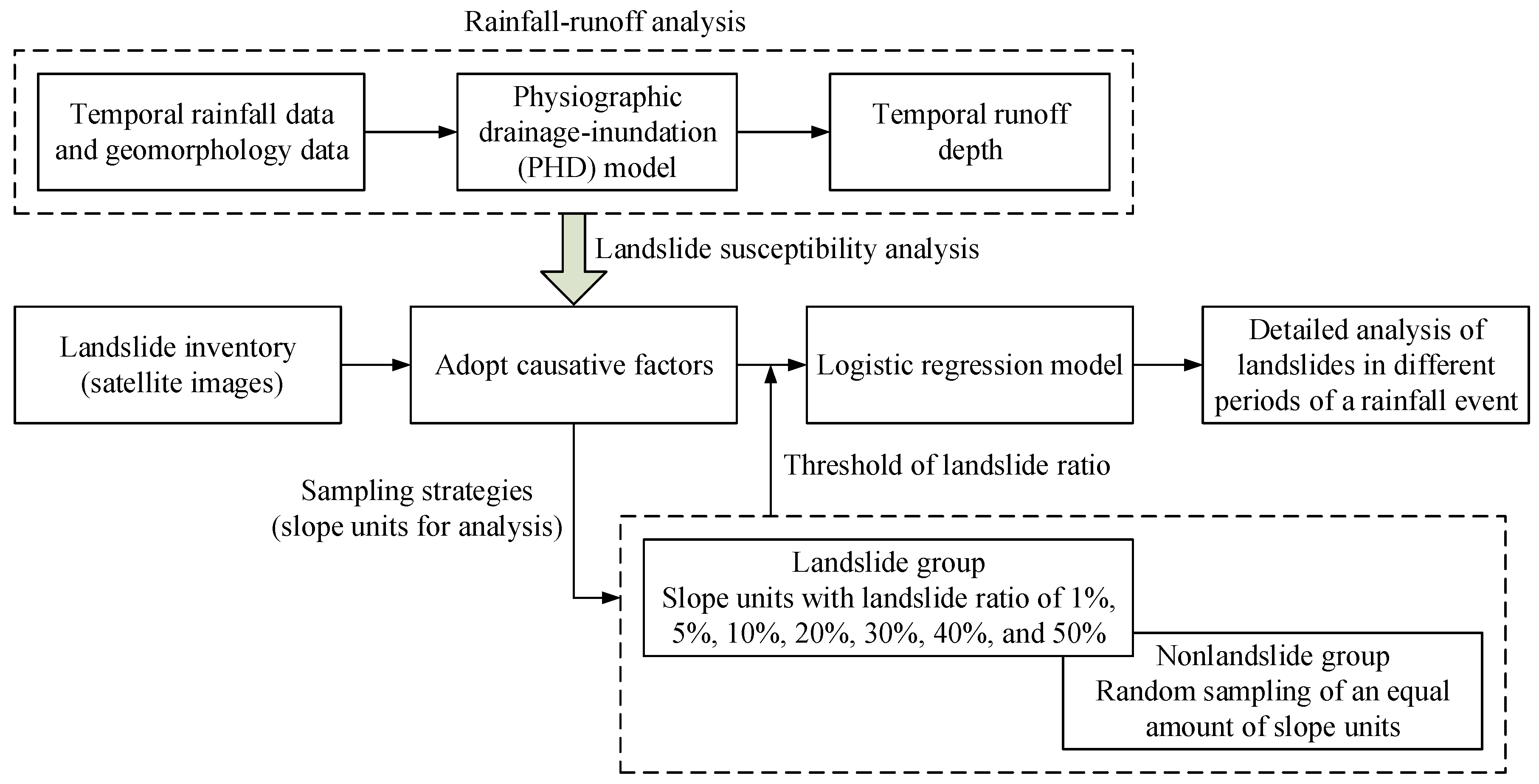
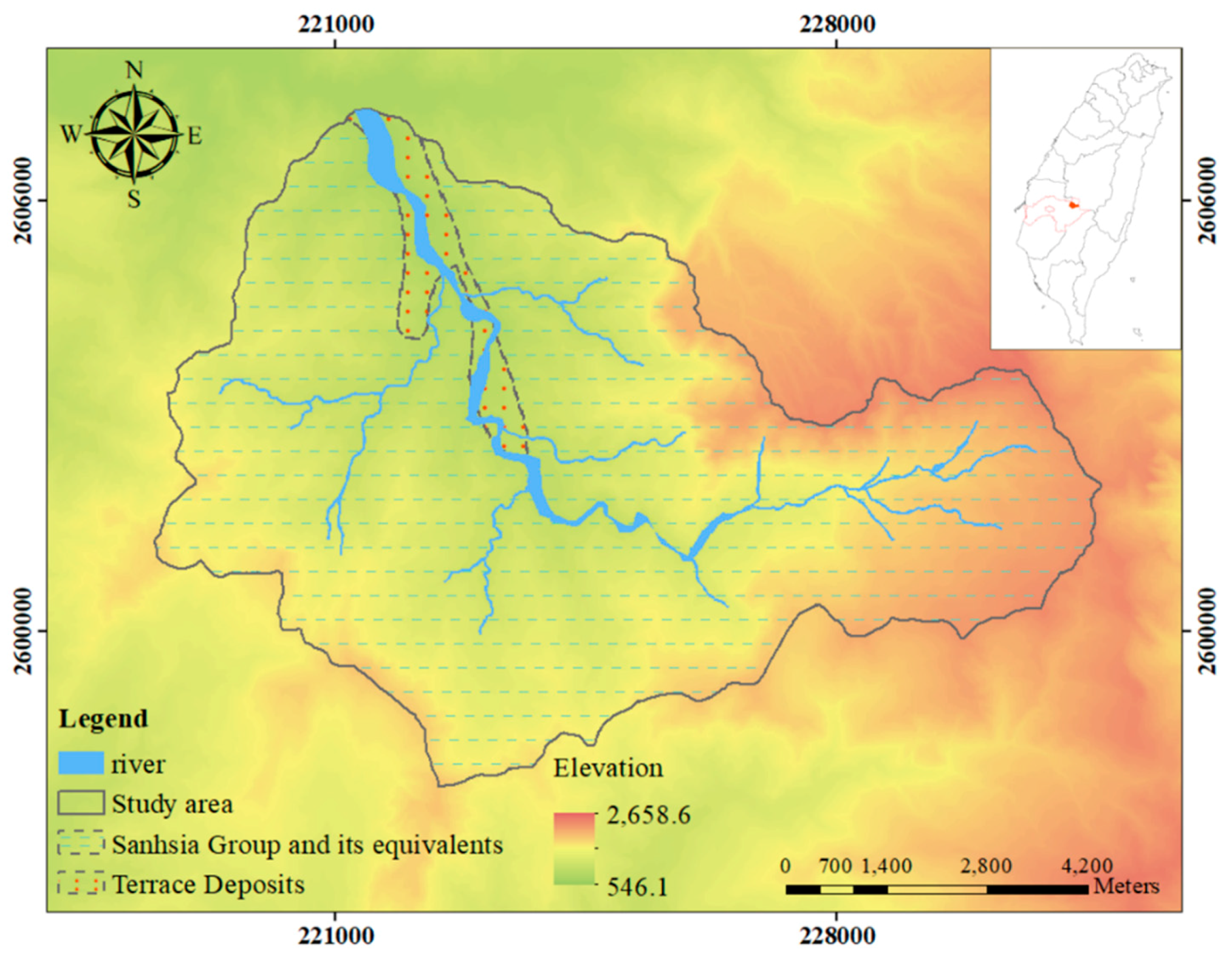
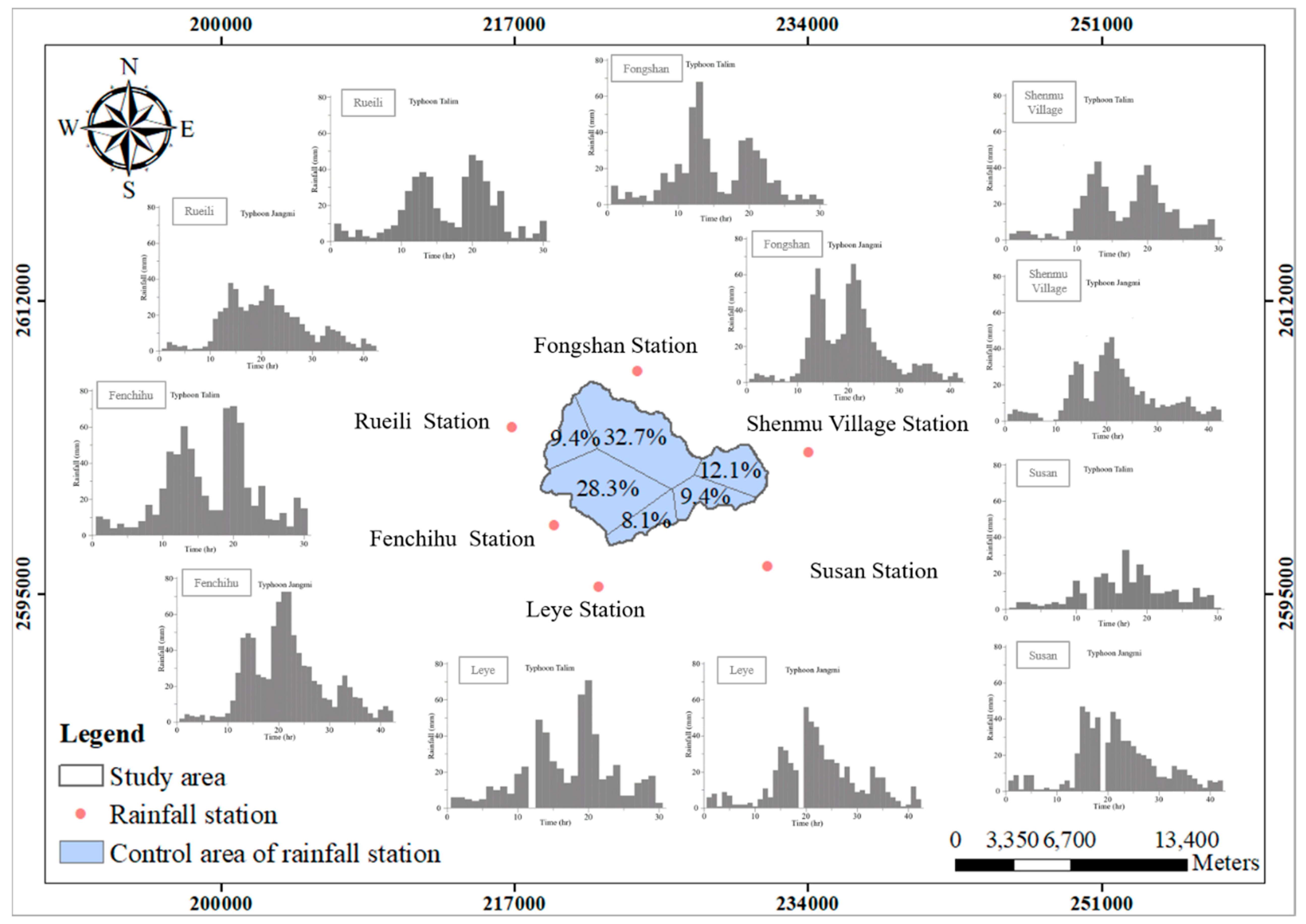

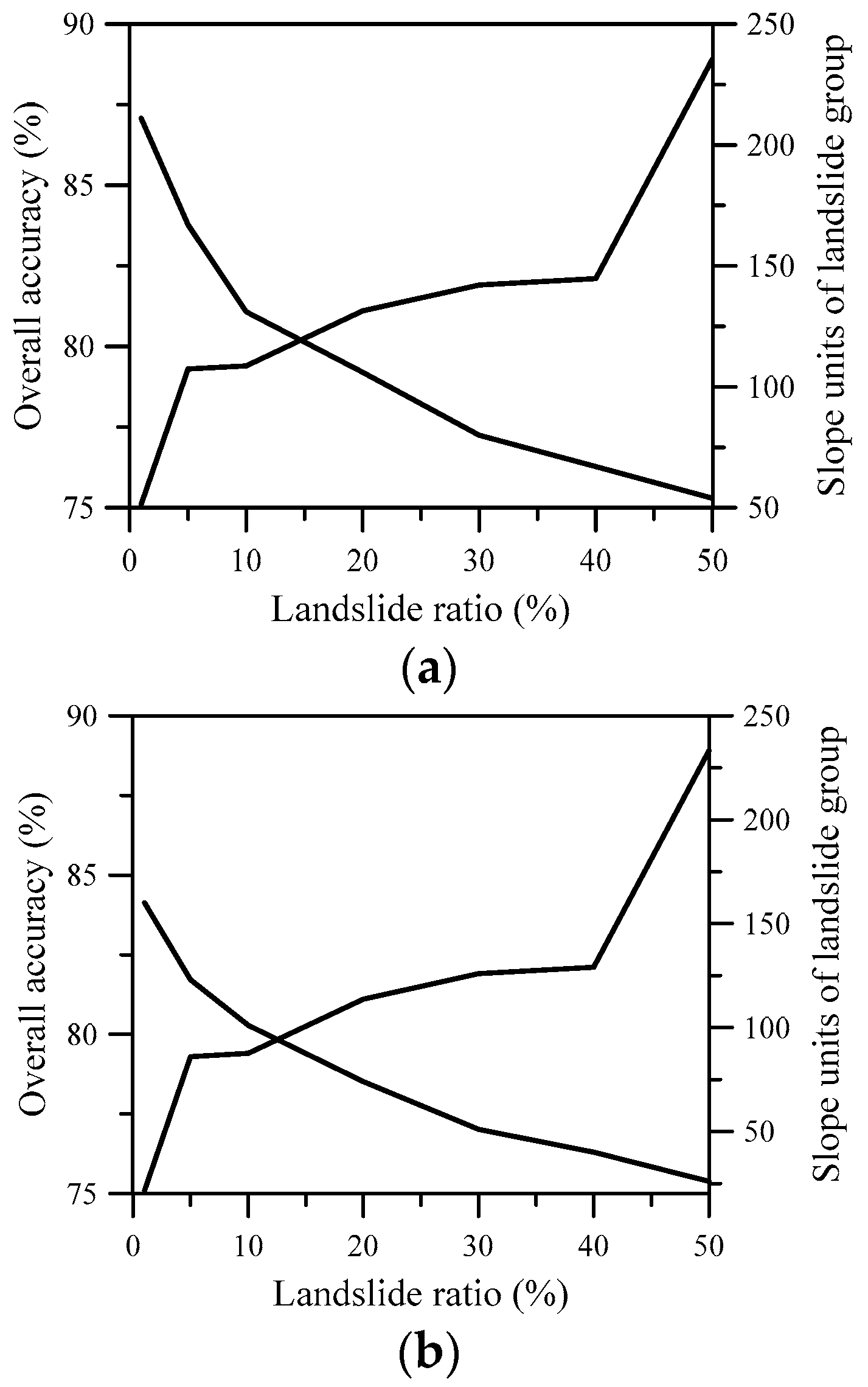
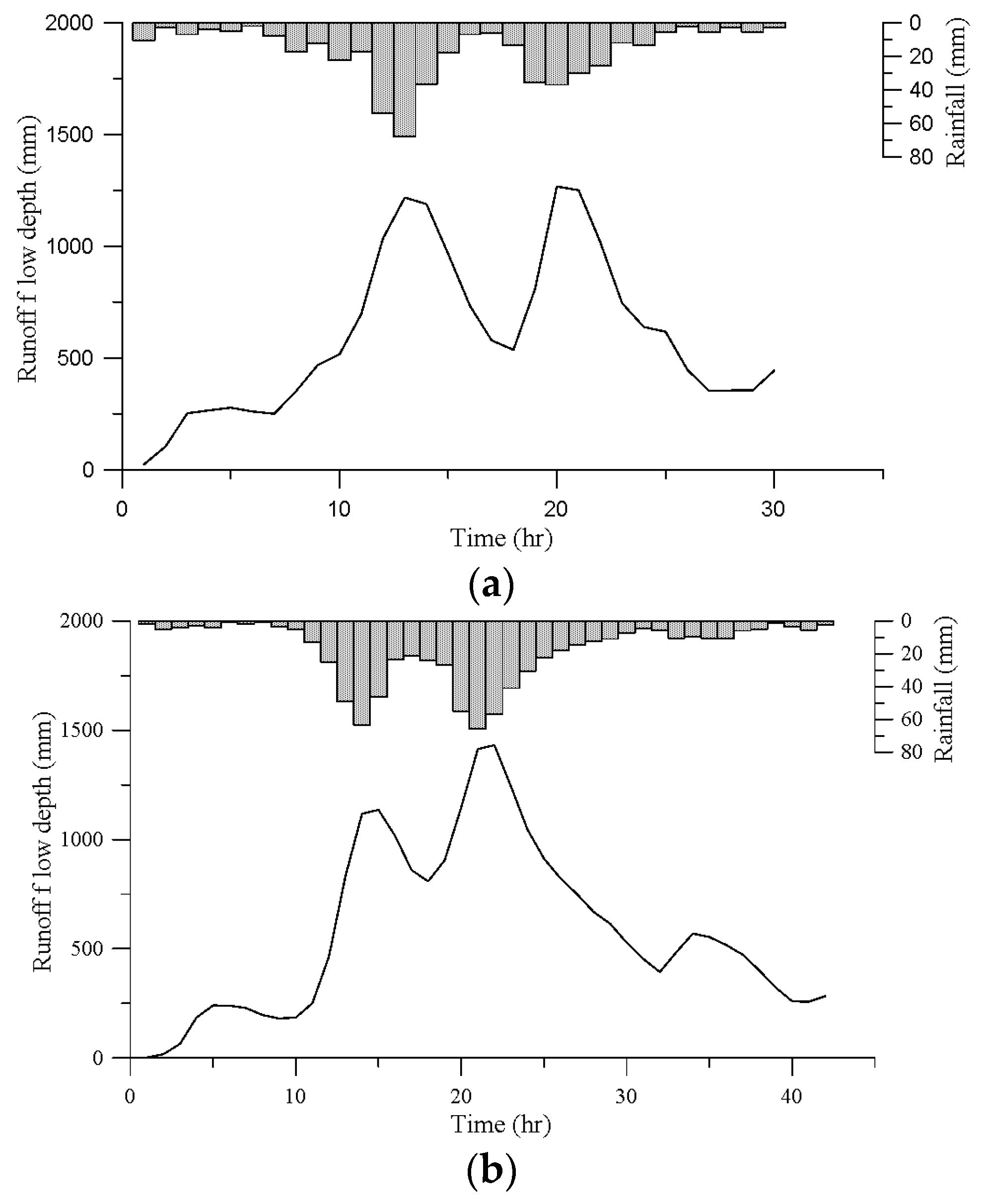

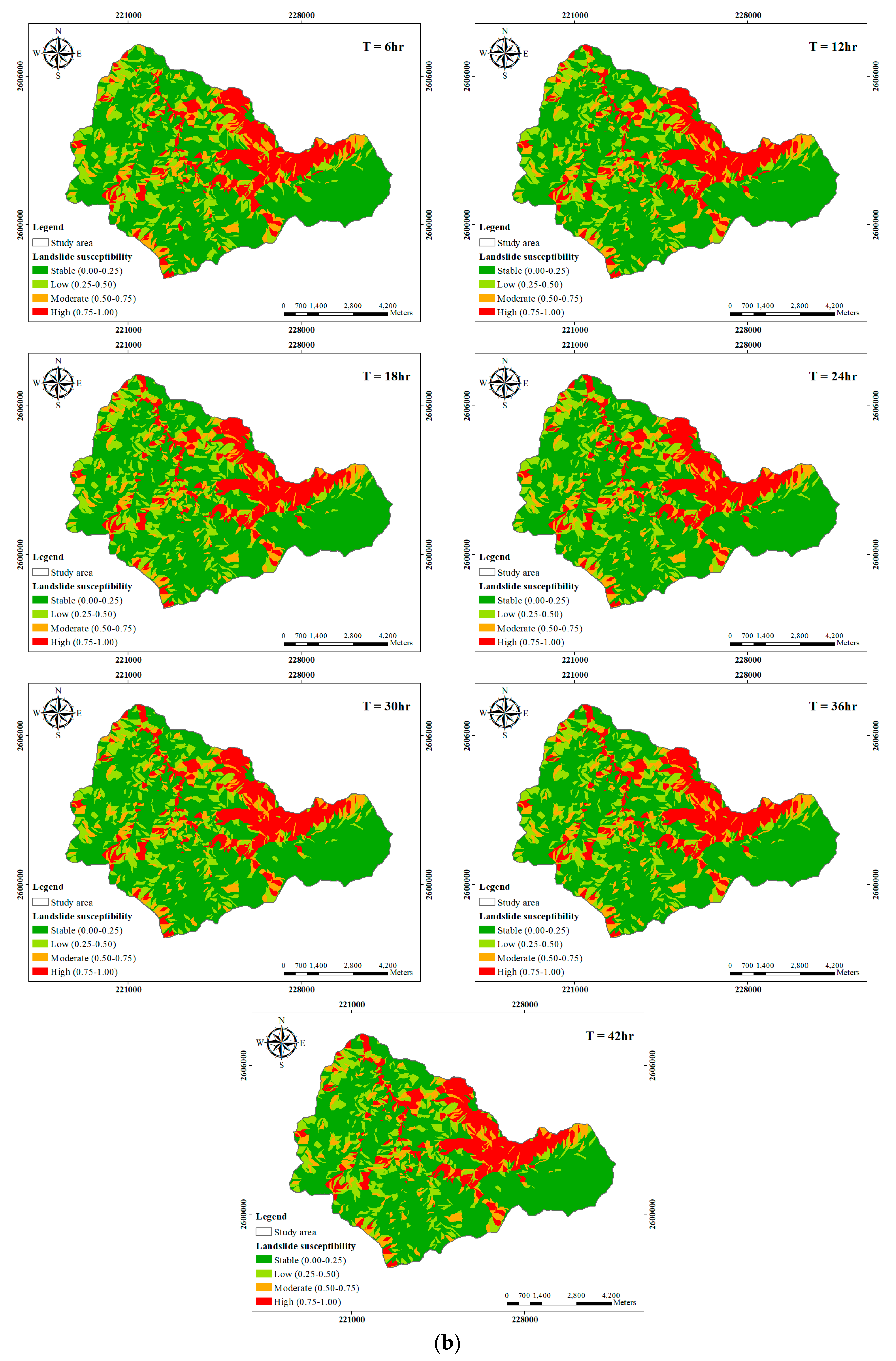
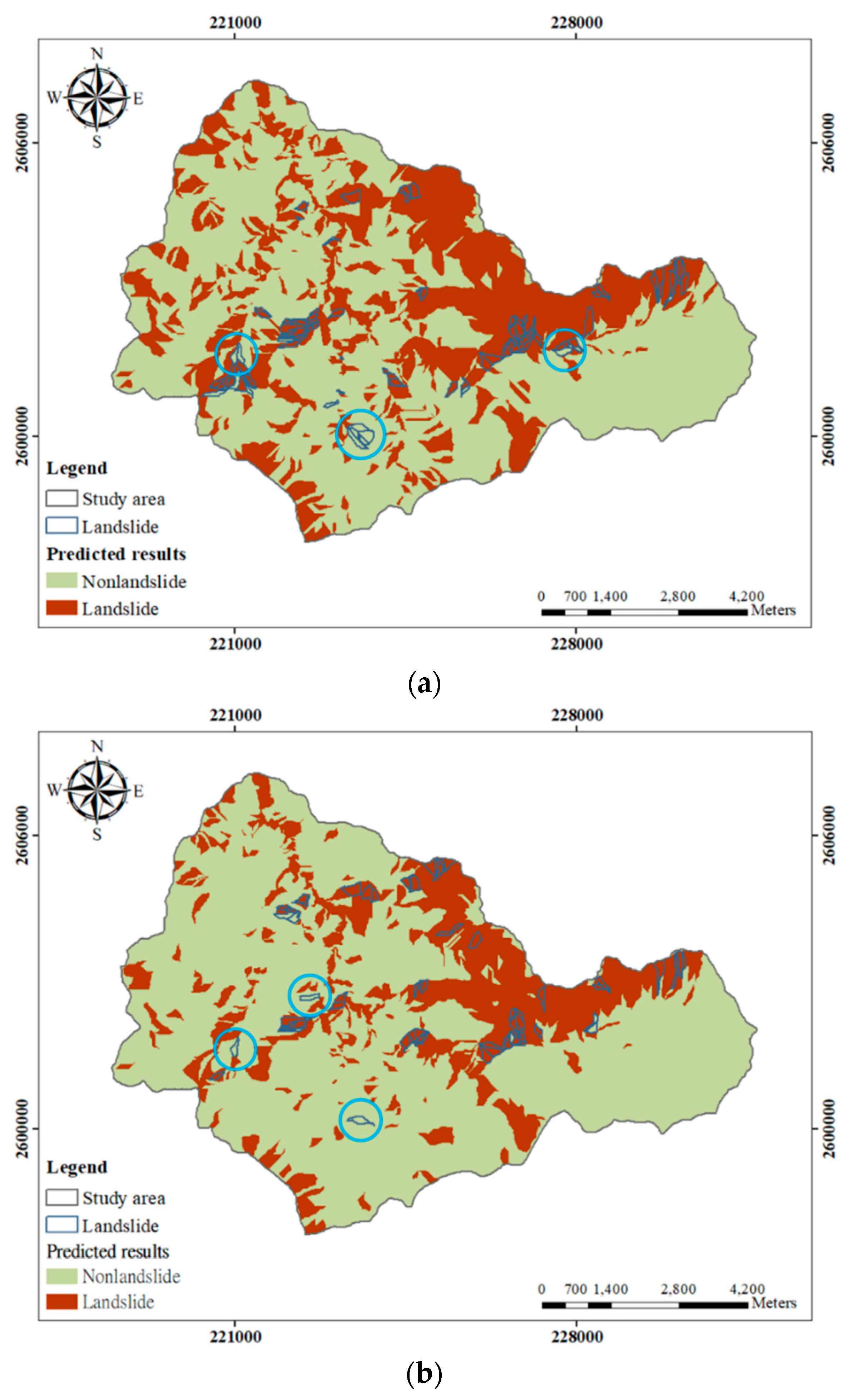
| Rainfall Station | Typhoon Talim | Typhoon Jangmi | ||||
|---|---|---|---|---|---|---|
| Rainfall Duration: 30 h | Rainfall Duration: 42 h | |||||
| Rainfall Depth (mm) | Maximum Rainfall Intensity (mm/h) | Averaged Rainfall Intensity (mm/h) | Rainfall Depth (mm) | Maximum Rainfall Intensity (mm/h) | Averaged Rainfall Intensity (mm/h) | |
| Shenmu Village | 444.5 | 43.5 | 14.8 | 584.0 | 46.5 | 13.9 |
| Fenqihu | 730.0 | 71.5 | 24.3 | 919.5 | 75.0 | 21.9 |
| Rueili | 500.0 | 48.0 | 16.7 | 591.0 | 38.0 | 14.1 |
| Fengshan | 491.0 | 68.0 | 16.4 | 733.5 | 66.0 | 17.5 |
| Shuishan | 285.0 | 33.0 | 9.5 | 605.0 | 47.0 | 14.4 |
| Leye | 588.0 | 80.0 | 19.6 | 636.0 | 56.0 | 15.1 |
| Landslide Ratio (%) | Typhoon Talim | Typhoon Jangmi | ||||||
|---|---|---|---|---|---|---|---|---|
| Overall Accuracy (%) | Mean | Standard Deviation | Slope Units for Landslide Group | Estimation Accuracy (%) | Mean | Standard Deviation | Slope Units for Landslide Group | |
| 1 | 69.5~75.1 | 71.5 | 1.6 | 211 | 74.4~82.5 | 78.4 | 1.8 | 160 |
| 5 | 70.1~79.3 | 74.1 | 2.0 | 167 | 77.6~85.8 | 81.7 | 1.6 | 123 |
| 10 | 69.8~79.4 | 74.7 | 2.1 | 131 | 73.8~87.6 | 81.5 | 2.4 | 101 |
| 20 | 68.9~81.1 | 73.8 | 2.7 | 106 | 79.7~88.5 | 83.8 | 2.1 | 74 |
| 30 | 68.1~81.9 | 75.3 | 2.7 | 80 | 78.4~90.2 | 85.6 | 2.6 | 51 |
| 40 | 67.2~82.1 | 74.0 | 4.0 | 67 | 76.3~91.3 | 84.6 | 3.4 | 40 |
| 50 | 69.4~88.9 | 78.5 | 4.1 | 54 | 75.0~96.2 | 86.1 | 5.0 | 26 |
| Event | Simulations | Total Rainfall Volume (m3) | Runoff Error | |
|---|---|---|---|---|
| Total Outlet Discharge (m3) | Depression Storage (m3) | |||
| Typhoon Talim | 34,944,289.2 | 1,011,033.8 | 36,376,655.0 | 1.16% |
| Typhoon Jangmi | 48,230,661.6 | 556,015.3 | 49,276,512.2 | 0.99% |
| Factor | Coefficient | Event | |||
|---|---|---|---|---|---|
| Typhoon Talim | Typhoon Jangmi | ||||
| Aspect | North | 16.89~17.21 | 14.53~19.88 | ||
| Northeast | 17.75~18.15 | 14.62~19.47 | |||
| East | 18.19~18.46 | 16.09~20.51 | |||
| Southeast | 18.44~19.00 | 15.85~19.93 | |||
| South | 19.03~19.17 | 16.21~20.04 | |||
| Southwest | 17.85~18.19 | 14.83~18.47 | |||
| West | 18.34~18.57 | 15.09~18.62 | |||
| Northwest | 17.98~18.31 | 13.95~16.18 | |||
| Slope | 1.71~1.83 | 2.54~3.16 | |||
| Runoff depth | 0.80~1.47 | 1.77~2.70 | |||
| Constant | C | – | −18.82~−18.67 | −20.39~−16.71 | |
| Assessments | Event | ||
|---|---|---|---|
| Typhoon Talim | Typhoon Jangmi | ||
| CEM (%) | For nonlandslide group | 79.2~81.1 | 83.8~90.5 |
| For landslide group | 80.2~83.0 | 85.1~87.8 | |
| Overall accuracy | 79.7~82.1 | 85.1~89.2 | |
| AUCs | 0.771~0.795 | 0.838~0.876 | |
© 2018 by the authors. Licensee MDPI, Basel, Switzerland. This article is an open access article distributed under the terms and conditions of the Creative Commons Attribution (CC BY) license (http://creativecommons.org/licenses/by/4.0/).
Share and Cite
Chan, H.-C.; Chen, P.-A.; Lee, J.-T. Rainfall-Induced Landslide Susceptibility Using a Rainfall–Runoff Model and Logistic Regression. Water 2018, 10, 1354. https://doi.org/10.3390/w10101354
Chan H-C, Chen P-A, Lee J-T. Rainfall-Induced Landslide Susceptibility Using a Rainfall–Runoff Model and Logistic Regression. Water. 2018; 10(10):1354. https://doi.org/10.3390/w10101354
Chicago/Turabian StyleChan, Hsun-Chuan, Po-An Chen, and Jung-Tai Lee. 2018. "Rainfall-Induced Landslide Susceptibility Using a Rainfall–Runoff Model and Logistic Regression" Water 10, no. 10: 1354. https://doi.org/10.3390/w10101354
APA StyleChan, H.-C., Chen, P.-A., & Lee, J.-T. (2018). Rainfall-Induced Landslide Susceptibility Using a Rainfall–Runoff Model and Logistic Regression. Water, 10(10), 1354. https://doi.org/10.3390/w10101354




